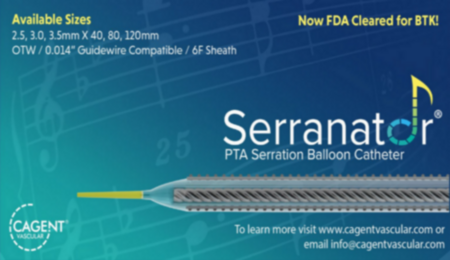Patient Background
A 76-year-old female with history of multifactorial, recurrent and severe PAD with chronic limb ischemia, who had undergone successful recanalization of bilateral lower extremity multilevel arterial occlusive disease in 2019, presented to the clinic in follow-up with complaints of progressive claudication at 25 feet, that since the office visit, has progressed to rest pain. A week prior to this procedure, she underwent angiography with recanalization with laser atherectomy of the right SFA and popliteal artery stents having developed severe in-stent intimal hyperplasia and thrombosis, despite being on anti-coagulation and dual antiplatelet therapy as well as a statin. At presentation today, she had complete resolution of RLE symptoms and palpable pedal pulses with LLE rest pain and only faint dopplerable pulses in her left foot.
Procedure
Left dorsalis pedis access was obtained with a 6 Fr Slender sheath placed. Retrograde access to the common femoral artery with angiography demonstrated occlusion of the SFA and above knee popliteal artery stents. The below knee popliteal was of small caliber but patent into a severely diseased posterior tibial that distally is sub-occlusive into a small caliber plantar artery. The peroneal also demonstrates severe distal disease. Successful recanalization of the SFA and popliteal artery stents was accomplished with laseratherectomy, stent and angioplasty. Brisk flow was reestablished to the runoff vessels with residual severe disease of the posterior tibial. Successful catheterization was made from the anterior tibial into the posterior tibial and plantar artery. A 2.5 x 120mm Serranator was easily advanced up and over from the anterior tibial through the posterior tibial disease into the plantar artery without pre-dilatation. The Serranator was inflated to 6ATM for 120 seconds. Completion angiography showed brisk and direct in-line flow from the SFA through popliteal and 3 vessel runoff with the posterior tibial widely patent and marked luminal gain without dissection or residual stenosis into the plantar artery. Palpable pedal pulses were present at discharge.
Conclusion
The Serranator balloon tracked easily up and over the tibial angle from anterior to posterior tibial artery without difficulty and was advanced through a severely diseased posterior tibial into the plantar artery without predilatation. Following serration angioplasty of the plantar through posterior tibial arteries with the Serranator, angiography revealed significant lumen gain in the PT, without dissection, recoil, or need for bailout tibial stenting. Pedal pulses were excellent upon discharge, after presenting with no palpable pulses prior to the procedure. This case is representative of the Serranator’s trackability without the need to predilate.
